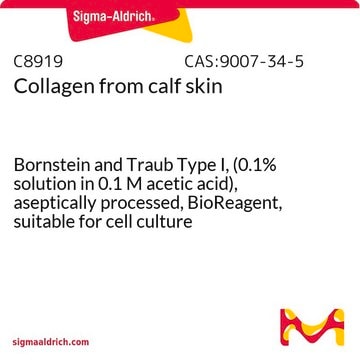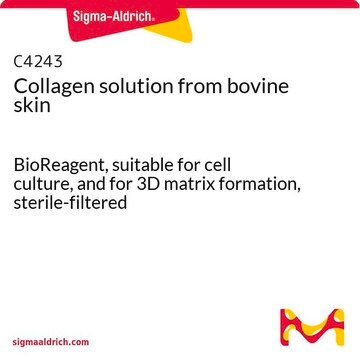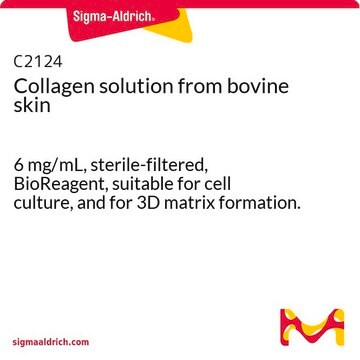C9791
Bovine Collagen Type I
from bovine skin, powder, suitable for cell culture
Synonim(y):
Type I collagen
About This Item
Polecane produkty
product name
Collagen from calf skin, Bornstein and Traub Type I, solid, BioReagent, suitable for cell culture
pochodzenie biologiczne
bovine (calf) skin
linia produktu
BioReagent
Postać
solid
opakowanie
poly bottle of 10 mg
poly bottle of 100 mg
poly bottle of 250 mg
poly bottle of 50 mg
metody
cell culture | mammalian: suitable
pokrycie powierzchni
6‑10 μg/cm2
rozpuszczalność
0.1 M acetic acid: 1 mg/mL (Allow to stir at room temperature 1-3 hours until dissolved.)
numer dostępu UniProt
Specyficzność wiązania
Peptide Source: Fibronectin
Peptide Source: Laminin
Warunki transportu
ambient
temp. przechowywania
2-8°C
informacje o genach
bovine ... COL1A1(282187)
Szukasz podobnych produktów? Odwiedź Przewodnik dotyczący porównywania produktów
Powiązane kategorie
Opis ogólny
Zastosowanie
- as a component of collagen gel matrix for culturing preantral follicles
- as a component of Roswell Park Memorial Institute, for culturing gilthead seabream kidney leukocytes and macrophages and acidophilic granulocytes
- to coat transwells prior to seeding of epithelial cell culture
Działania biochem./fizjol.
Komponenty
Uwaga dotycząca przygotowania
Inne uwagi
Kod klasy składowania
11 - Combustible Solids
Klasa zagrożenia wodnego (WGK)
WGK 1
Temperatura zapłonu (°F)
Not applicable
Temperatura zapłonu (°C)
Not applicable
Środki ochrony indywidualnej
Eyeshields, Gloves, type N95 (US)
Certyfikaty analizy (CoA)
Poszukaj Certyfikaty analizy (CoA), wpisując numer partii/serii produktów. Numery serii i partii można znaleźć na etykiecie produktu po słowach „seria” lub „partia”.
Masz już ten produkt?
Dokumenty związane z niedawno zakupionymi produktami zostały zamieszczone w Bibliotece dokumentów.
Klienci oglądali również te produkty
Produkty
Białka macierzy zewnątrzkomórkowej, takie jak laminina, kolagen i fibronektyna, mogą być stosowane jako podłoża do mocowania komórek w hodowli komórkowej.
Extracellular matrix proteins such as laminin, collagen, and fibronectin can be used as cell attachment substrates in cell culture.
Cancer stem cell media, spheroid plates and cancer stem cell markers to culture and characterize CSC populations.
Nasz zespół naukowców ma doświadczenie we wszystkich obszarach badań, w tym w naukach przyrodniczych, materiałoznawstwie, syntezie chemicznej, chromatografii, analityce i wielu innych dziedzinach.
Skontaktuj się z zespołem ds. pomocy technicznej









